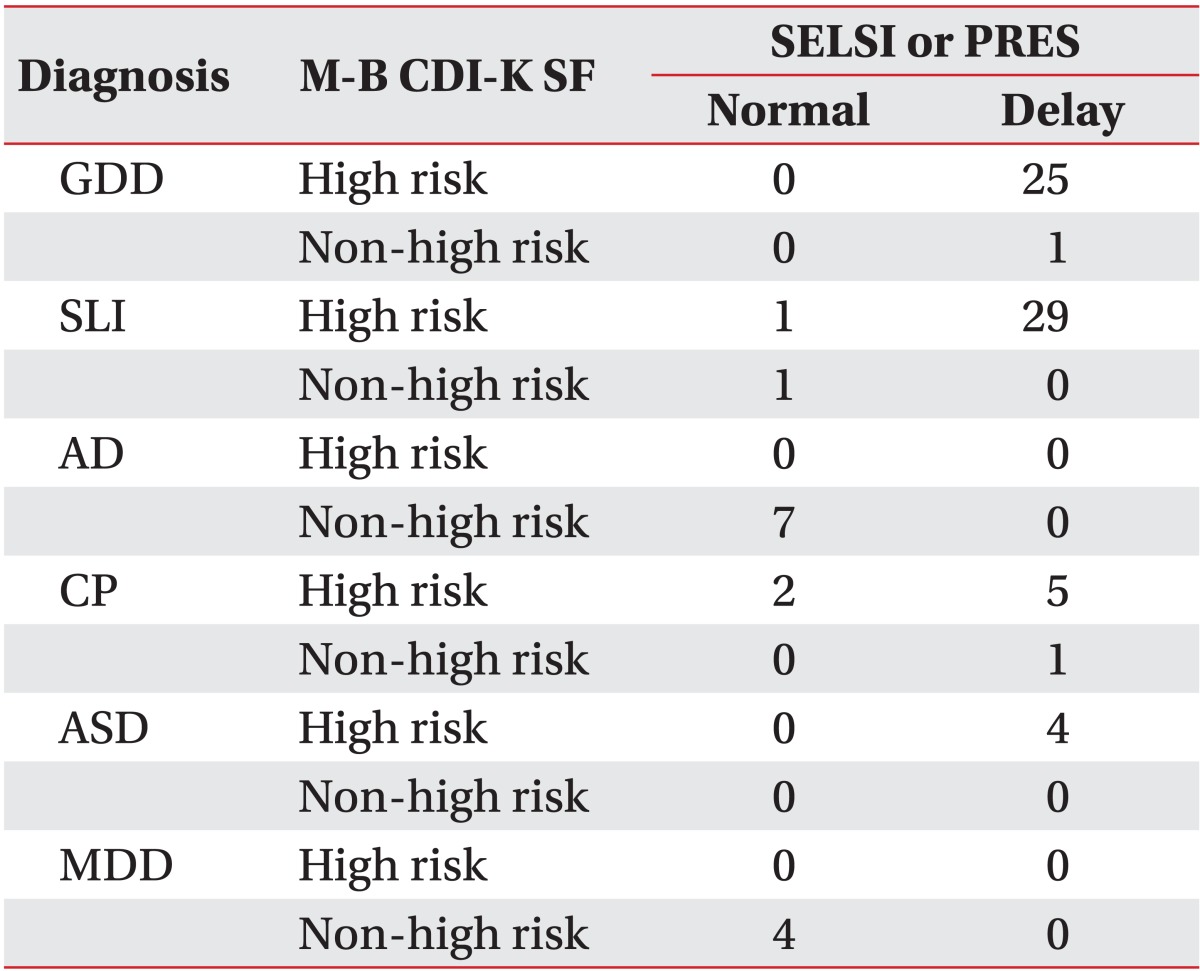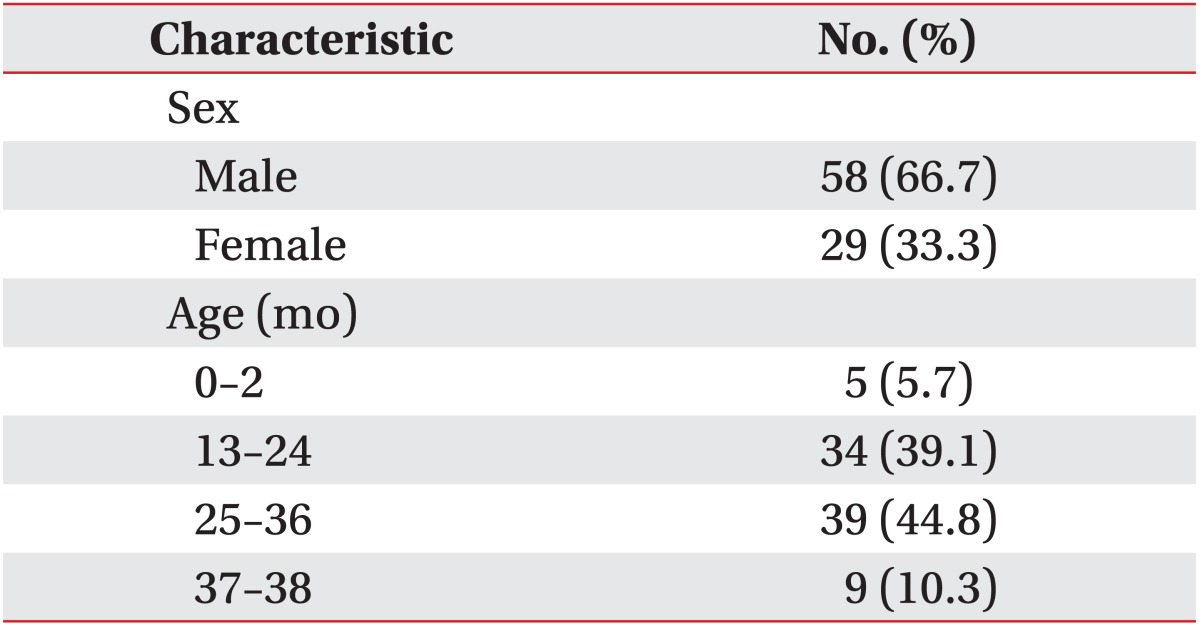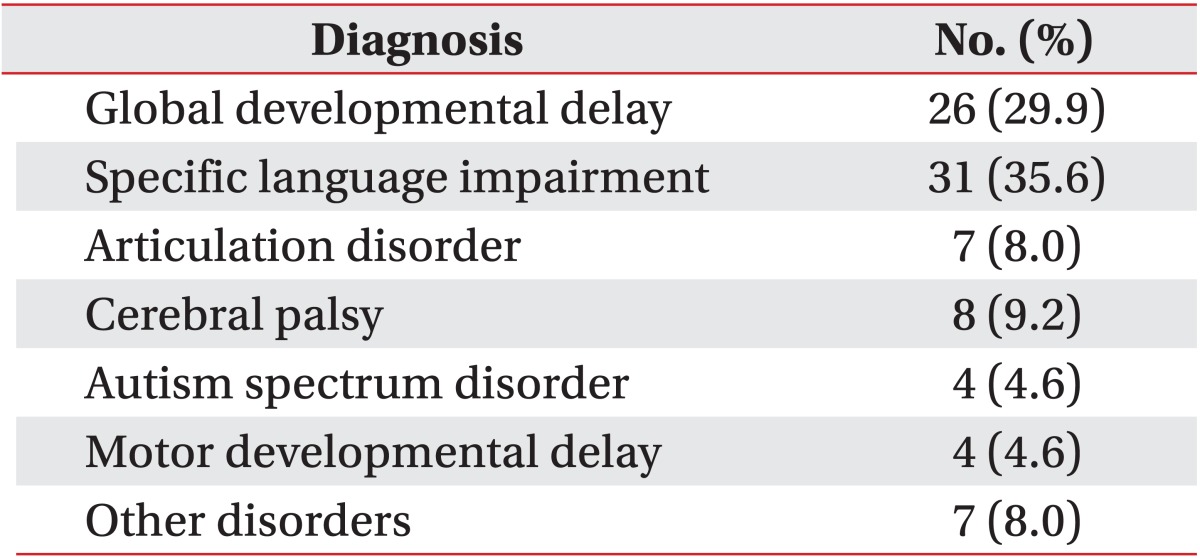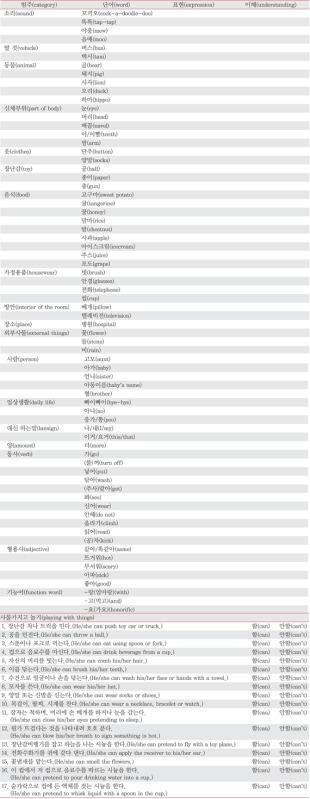1. Pae SY, Kwak KJ, Kim MB, Lee HS, Jung KH. Short form versions of MacArthur-Bates Communicative Development Inventories - Korean (M-B CDI-K). J Korean Soc Speech Sci. 2008; 15:119–129.
2. Jang JH, Park ES, Park JH, Baek JH, Won YH, Rha DW. Clinical usefulness of Capute developmental test as a screening test for detecting the language delay. J Korean Acad Rehabil Med. 2010; 34:544–549.
3. Randall D, Reynell J, Curwen M. A study of language development in a sample of 3 year old children. Br J Disord Commun. 1974; 9:3–16. PMID:
4433458.

4. Burden V, Stott CM, Forge J, Goodyer I. The Cambridge Language and Speech Project (CLASP). I. Detection of language difficulties at 36 to 39 months. Dev Med Child Neurol. 1996; 38:613–631. PMID:
8674912.
5. Kim YT, Kim KH, Yoon HR, Kim WS. Sequenced language scale for infants (SELSI). 1st ed. Seoul: Special Education Publication Co.;2003.
6. Kim YT, Sung TJ, Lee YK. Preschool receptive-expressive language scale (PRES). 1st ed. Seoul: Seoul Welfare Center for People with Disabilities;2003.
7. Reese E, Read S. Predictive validity of the New Zealand MacArthur Communicative Development Inventory: words and sentences. J Child Lang. 2000; 27:255–266. PMID:
10967887.

8. Westerlund M, Berglund E, Eriksson M. Can severely language delayed 3-year-olds be identified at 18 months? Evaluation of a screening version of the MacArthur-Bates Communicative Development Inventories. J Speech Lang Hear Res. 2006; 49:237–247. PMID:
16671841.

9. Vach W, Bleses D, Jorgensen R. Construction of a Danish CDI short form for language screening at the age of 36 months: methodological considerations and results. Clin Linguist Phon. 2010; 24:602–621. PMID:
20524850.

10. Lee YK. The relationships among language, communicative abilities and motor, cognitive, and socio-emotional development in toddlers with language delays. Korean J Commun Disord. 2011; 16:1–12.
11. Pae SY. Validity and reliability of the Korean adaptation of MCDI. Korean J Commun Disord. 2003; 8:1–14.
12. Harel S, Greenstein Y, Kramer U, Yifat R, Samuel E, Nevo Y, et al. Clinical characteristics of children referred to a child development center for evaluation of speech, language, and communication disorders. Pediatr Neurol. 1996; 15:305–311. PMID:
8972529.

13. Kim SW, Shin JB, You S, Yang EJ, Lee SK, Chung HJ, et al. Diagnosis and clinical features of children with language delay. J Korean Acad Rehabil Med. 2005; 29:584–590.
14. Glascoe FP, Byrne KE, Ashford LG, Johnson KL, Chang B, Strickland B. Accuracy of the Denver-II in developmental screening. Pediatrics. 1992; 89(6 Pt 2):1221–1225. PMID:
1375732.

15. Ga HY, Kwon JY. A comparison of the Korean-ages and stages questionnaires and Denver developmental delay screening test. Ann Rehabil Med. 2011; 35:369–374. PMID:
22506146.

16. Deakin-Bell N, Walker K, Badawi N. The accuracy of parental concern expressed in the Ages and Stages Questionnaire to predict developmental delay. J Paediatr Child Health. 2013; 49:E133–E136. PMID:
23336747.

17. Guiberson M, Rodriguez BL. Measurement properties and classification accuracy of two spanish parent surveys of language development for preschool-age children. Am J Speech Lang Pathol. 2010; 19:225–237. PMID:
20484705.

18. Borowitz KC, Glascoe FP. Sensitivity of the Denver Developmental Screening Test in speech and language screening. Pediatrics. 1986; 78:1075–1078. PMID:
3786032.

19. Kim SW, Shin JB, Kim EH, Lee SK, Jung HJ, Song DH. Diagnosis and clinical features in children referred to developmental delay Clinic. J Korean Acad Rehabil Med. 2004; 28:132–139.
20. Rydz D, Shevell MI, Majnemer A, Oskoui M. Developmental screening. J Child Neurol. 2005; 20:4–21. PMID:
15791916.
21. Frankenburg WK. Developmental surveillance and screening of infants and young children. Pediatrics. 2002; 109:144–145. PMID:
11773555.






 PDF
PDF ePub
ePub Citation
Citation Print
Print






 XML Download
XML Download